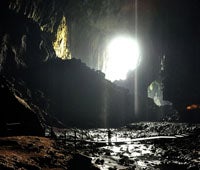Wilderness Wonders: Biggest Cave

'biggest cave, Deer Cave, Mulu National Park, Malaysia'
Biggest Cave | Scariest Predator | Driest Desert | Hottest Geysers | Largest Glacier | Highest Peak | Tallest Tree | Highest Biodiversity | Largest Primate | Most Active Volcano | Strangest Rock Formation | Biggest Bear | Largest Crater | Farthest Migrator | Tallest Waterfall
What Bats, salamanders, fish, and eyeless arthropods lurk among the stalactites and stalagmites of the world’s underground caverns. Even cooler: Experts estimate that only 10 percent of all caves have been explored. The archetypal chambers owe their existence to carbonic acid from groundwater and rain–when the acid reaches limestone or other soft subterranean rock, it eats through to form deep, long caverns like Abkhazia, Georgia’s Voronya Cave (reaching 7,190 feet beneath the earth’s surface) and Kentucky’s Mammoth Cave (stretching nearly 350 miles).
Where Gunung Mulu National Park, Malaysia. Tour the highlights of this park’s 186 miles of mapped passages. Take a three-hour riverside hike to reach the planet’s biggest cave chamber, Sarawak Chamber (it can hold 10 jumbo jets lined up nose to tail), or explore Deer Cave, where 3 million wrinkle-lipped bats make a nightly appearance. Above ground, traverse a remote jungle wilderness on the seven-mile Headhunter’s Trail, a traditional path once used by warring Borneo natives (guides required for cave tours and highly recommended for hiking). mulupark.com